-
Countries
-
Data and Analysis
-
Special Focus
-
Crisis Responses
Assessment Report
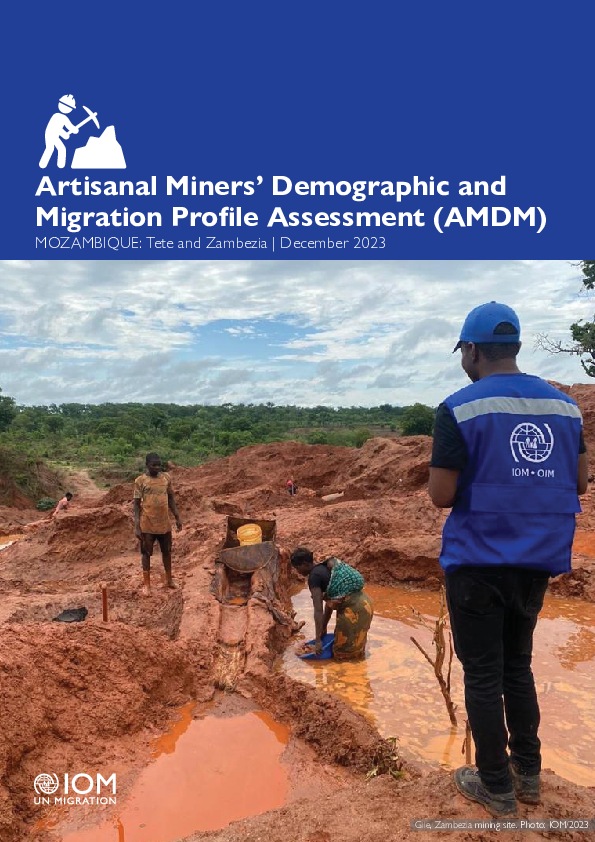
Contact
DTM Mozambique, DTMMozambique@iom.int
Language
English
Location
Mozambique
Period Covered
Nov 26 2023
Dec 02 2023
Activity
- Other
- Survey
Artisanal mineral extraction attracts high numbers of migrants within Mozambique, and the southern African region more widely. These informal mining points are particularly vulnerable to communicable diseases, and communities often have limited access to basic social infrastructure, including health facilities.
The Artisanal Miners' Demographic and Migration Profile Assessment (AMDM) aimed to explore the socio-economic and migratory patterns of artisanal miners in two significant locations: Gile, Zambezia, and Cahora Bassa, Tete. In focusing on these two remote mining areas in Zambezia and Tete respectively, the AMDM provides an evidence base that complements IOM's support to a migrant-friendly health service model that bridges gaps between migrants and host communities in vulnerable regions.

Contact
IraqDTM@iom.int
Language
English
Location
Iraq
Period Covered
May 01 2023
Aug 01 2023
Activity
- Survey
With the end of the conflict with the Islamic State of Iraq and the Levant (ISIL), protracted displacement has come to characterize the post-conflict environment in Iraq. Around 1.14 million people remain internally displaced, nearly all of whom fled their areas of origin more than five years ago. In light of the above, it is essential to advance durable solutions to displacement in Iraq by improving living conditions to enable internally displaced persons (IDPs) to voluntarily take steps towards return, local integration or settlement in new locations. The Displacement Index (DI) is a tool designed to measure and monitor the living conditions of IDPs. Data collection for DI Round 7 took place between May and August 2023 across 18 governorates, 103 districts and 2,614 locations of Iraq. During this round, 24 fewer locations of displacement were assessed, compared to the previous round collected in January – April 2023, when 2,638 locations were assessed, as IDPs either returned to their areas of origin or moved to another location of displacement.
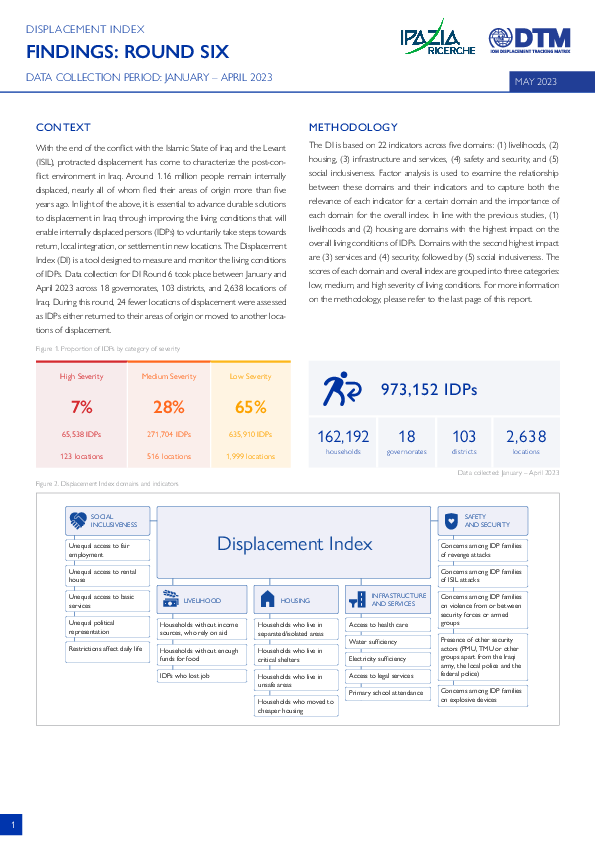
Contact
IraqDTM@iom.int
Language
English
Location
Iraq
Period Covered
Jan 01 2023
Apr 01 2023
Activity
- Survey
With the end of the conflict with the Islamic State of Iraq and the Levant (ISIL), protracted displacement has come to characterize the post-conflict environment in Iraq. Around 1.16 million people remain internally displaced, nearly all of whom fled their areas of origin more than five years ago. In light of the above, it is essential to advance durable solutions to displacement in Iraq through improving the living conditions that will enable internally displaced persons (IDPs) to voluntarily take steps towards return, local integration, or settlement in new locations. The Displacement Index (DI) is a tool designed to measure and monitor the living conditions of IDPs. Data collection for DI Round 6 took place between January and April 2023 across 18 governorates, 103 districts, and 2,638 locations of Iraq. During this round, 24 fewer locations of displacement were assessed as IDPs either returned to their areas of origin or moved to another locations of displacement.
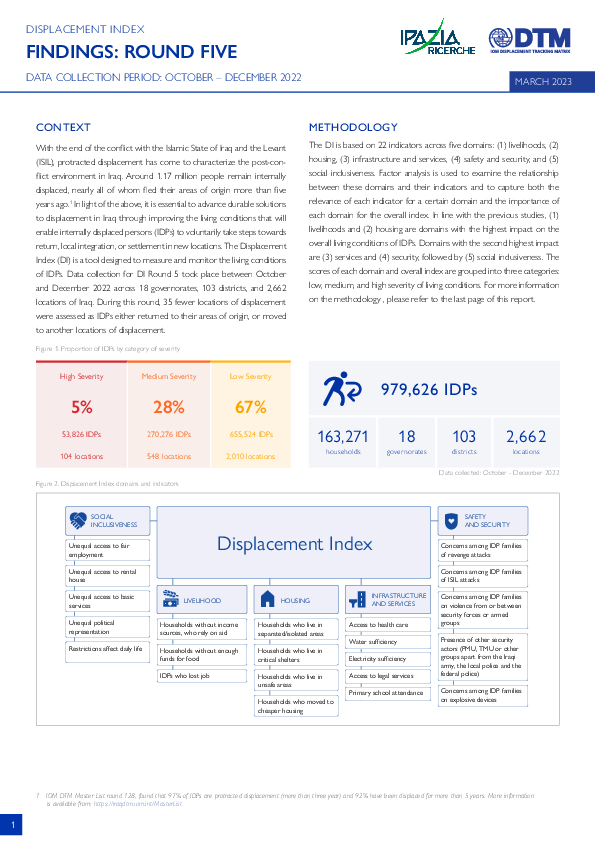
Contact
IraqDTM@iom.int
Language
English
Location
Iraq
Period Covered
Oct 01 2022
Dec 01 2022
Activity
- Survey
With the end of the conflict with the Islamic State of Iraq and the Levant (ISIL), protracted displacement has come to characterize the post-conflict environment in Iraq. Around 1.17 million people remain internally displaced, nearly all of whom fled their areas of origin more than five years ago.1 In light of the above, it is essential to advance durable solutions to displacement in Iraq through improving the living conditions that will enable internally displaced persons (IDPs) to voluntarily take steps towards return, local integration, or settlement in new locations. The Displacement Index (DI) is a tool designed to measure and monitor the living conditions of IDPs. Data collection for DI Round 5 took place between October and December 2022 across 18 governorates, 103 districts, and 2,662 locations of Iraq. During this round, 35 fewer locations of displacement were assessed as IDPs either returned to their areas of origin, or moved to another locations of displacement.
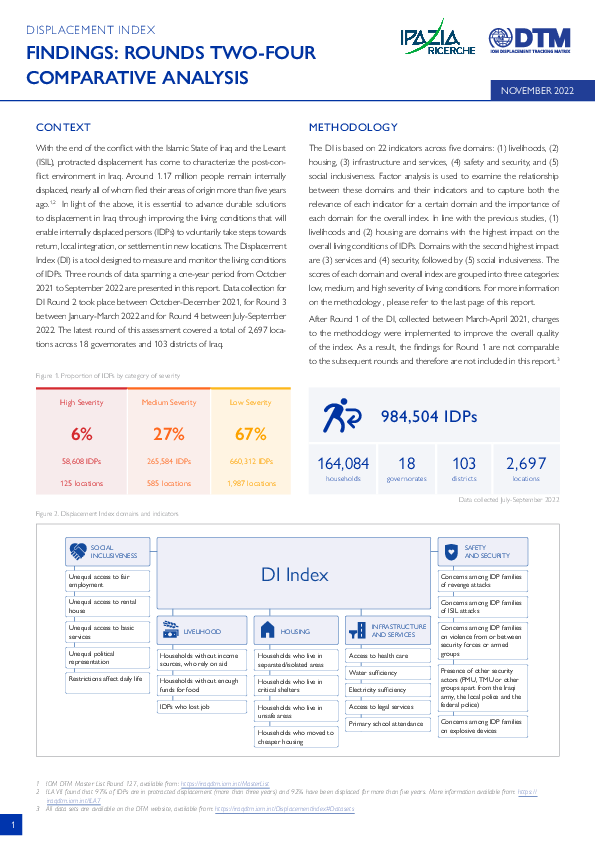
Contact
IraqDTM@iom.int
Language
English
Location
Iraq
Period Covered
Oct 01 2021
Sep 01 2022
Activity
- Survey
With the end of the conflict with the Islamic State of Iraq and the Levant (ISIL), protracted displacement has come to characterize the post-conflict environment in Iraq. Around 1.17 million people remain internally displaced, nearly all of whom fled their areas of origin more than five years ago.1,2 In light of the above, it is essential to advance durable solutions to displacement in Iraq through improving the living conditions that will enable internally displaced persons (IDPs) to voluntarily take steps towards return, local integration, or settlement in new locations. The Displacement Index (DI) is a tool designed to measure and monitor the living conditions of IDPs. Three rounds of data spanning a one-year period from October 2021 to September 2022 are presented in this report. Data collection for DI Round 2 took place between October-December 2021, for Round 3 between January-March 2022 and for Round 4 between July-September 2022. The latest round of this assessment covered a total of 2,697 locations across 18 governorates and 103 districts of Iraq.
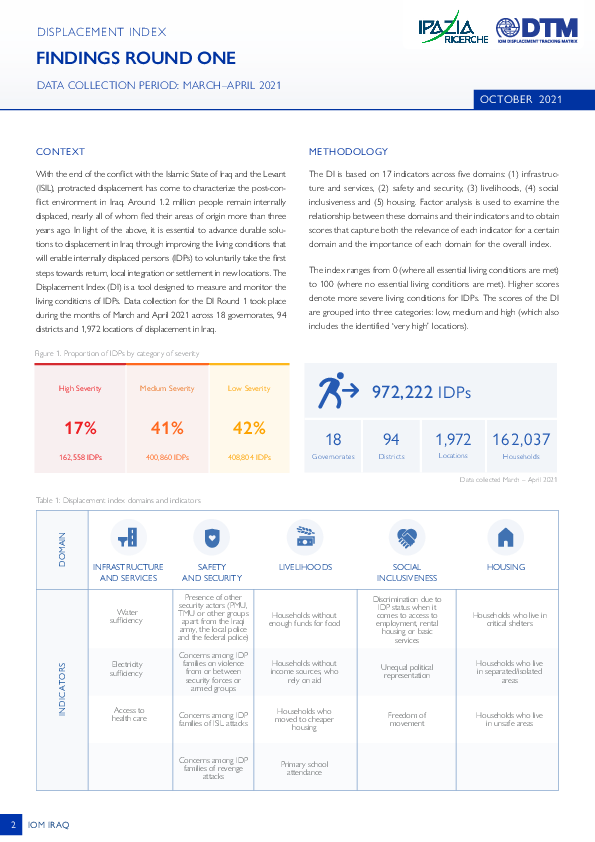
Contact
IraqDTM@iom.int
Language
English
Location
Iraq
Period Covered
Mar 01 2021
Apr 01 2021
Activity
- Survey
With the end of the conflict with the Islamic State of Iraq and the Levant (ISIL), protracted displacement has come to characterize the post-conflict environment in Iraq. Around 1.2 million people remain internally displaced, nearly all of whom fled their areas of origin more than three years ago. In light of the above, it is essential to advance durable solutions to displacement in Iraq through improving the living conditions that will enable internally displaced persons (IDPs) to voluntarily take the first steps towards return, local integration or settlement in new locations. The Displacement Index (DI) is a tool designed to measure and monitor the living conditions of IDPs. Data collection for the DI Round 1 took place during the months of March and April 2021 across 18 governorates, 94 districts and 1,972 locations of displacement in Iraq.

Contact
DTMUkraine@iom.int
Language
English
Location
Ukraine
Period Covered
Feb 01 2024
Feb 29 2024
Activity
- Baseline Assessment
Базова територіальна оцінка зареєстрованих ВПО надає деталізовані дані щодо чисельності та географічного розподілу офіційно зареєстрованих внутрішньо переміщених осіб (ВПО). У звіті оцінено присутність зареєстрованих ВПО на рівні громад із відображенням на мапі зафіксованих змін порівняно з попереднім раундом.
Дані, зібрані для раунду 33 Базової територіальної оцінки, відображають актуальну статистику з місцевого адміністративного реєстру ВПО станом на 29 лютого 2024 року, згідно з якою в Україні налічується 3 413 472 зареєстровані ВПО. Дані щодо кількості зареєстрованих ВПО було зібрано для 1 098 громад (83% усіх оцінених громад на підконтрольних українському уряду територіях) у 108 районах 23 областей. Дані з розподілом за віком, статтю та статусом інвалідності було надано для приблизно 83% оцінених адміністративно-територіальних одиниць.
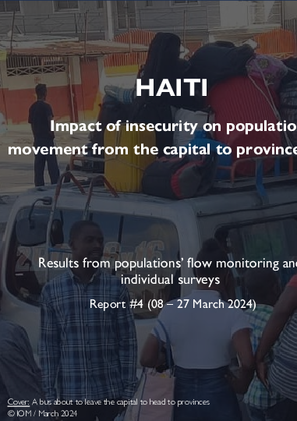
Contact
DTM Haiti, dtmhaiti@iom.int
Language
English
Location
Haiti
Period Covered
Mar 08 2024
Mar 27 2024
Activity
- Survey
- Flow Monitoring Survey
- Flow Monitoring
In recent weeks, armed attacks have intensified in the Metropolitan Area of Port-Au-Prince (MAPAP), the capital of Haiti. In addition to creating displacement within the MAPAP, attacks and generalized insecurity are pushing more and more people to leave the capital to find refuge in provinces, taking the risks of passing through gangs-controlled routes. In order to monitor these movements towards provinces and inform appropriate response strategies, DTM has launched data collection at several of the most used bus stations in the capital (see page 5 for more details on the methodology). Since the start of this activity, on 8 March, until 27 March, this activity allowed to observe the movements of 53,125 people leaving the MAPAP (see pages 3 and 4 for more details on the profile of these people ). The majority of them (61%) took means of transport heading towards the Grand Sud departments (Grande’Anse, South, Nippes and South-East). It should be noted that this region already hosts more than 116,000 people who had in vast majority, fled the MAPAP in recent months (see the report on displacement in the Grand Sud).
It should be emphasized that provinces do not have sufficient infrastructures and host communities do not have sufficient resources that can enable them to cope with these massive displacement flows coming from the capital.

Contact
dtmremapsupport@iom.int mtmtajikistan@iom.int
Language
English
Location
Tajikistan
Period Covered
Sep 13 2023
Nov 11 2023
Activity
- Survey
- Baseline Assessment
The surveys were conducted with return migrant workers using IOM’s Mobility Tracking Matrix (MTM) system in Tajikistan. The survey locations were selected based on the results of IOM’s Baseline Mobility Assessment on returning migrant workers. The report includes findings on socio-economic profile, migration experience, employment and remittances. The survey sample was calculated based on a Baseline Assessment on the presence of returning migrant workers in the selected locations. The interviews were conducted using mobile devices and the KoBo software. All interviews were anonymous, and IOM’s Data Protection Principles were observed throughout the entire data cycle. Data collectors approached potential respondents using the snowball method to obtain their informed consent.

Contact
DTM Sudan, DTMSudan@iom.int
Language
English
Location
Sudan
Period Covered
Feb 22 2024
Mar 21 2024
Activity
- Mobility Tracking
- Baseline Assessment
This report reflects data corresponding to Monthly Displacement Overview 07 dataset, valid as of 21 March 2024. The dataset is available here.
Overview
IOM DTM Sudan presents its seventh Monthly Displacement Overview. This publication provides an account of Sudan’s displacement context since 15 April 2023 – outlining population mobility and displacement, as well as the present and evolving needs of IDPs across Sudan. It provides further contextual analysis for all 18 states for the period between 22 February and 21 March 2024.
Rationale
Recognizing the need for more detailed insights into the IDP situation, including the priority needs, access to services, movement intentions, and demographic breakdowns of the affected population, DTM Sudan has undertaken a comprehensive review of our data collection tool. In collaboration with a wide range of internal and external stakeholders, we have developed a new tool to better inform humanitarian response operations, aligning with the DTM global methodology. Leveraging our extensive network of approximately 367 field-based enumerators and a robust system of over 3,362 key informants across the country, DTM gathered data on IDPs across 7,037 locations, in 181 of Sudan’s 189 localities, across all of Sudan’s 18 states, during March 2024.
Key Findings
- DTM Sudan estimates that 6,552,118 individuals (1,308,617 households) have been recently internally displaced.
- IOM DTM also reports that an estimated 2,019,027 mixed cross-border movements have been made into neighbouring countries.
- Since 15 April 2023, 46 per cent of the IDP caseload sought refuge in the Darfur and Kordofan regions, whereas 53 per cent were observed across the Northern, Eastern, and Central states.
- The majority of the IDP caseload (66%) were seeking shelter with the host community.
- While food remains the highest priority need, health and non-food items are also growing concerns.
Pagination
- Previous page
- Page 40
- Next page
